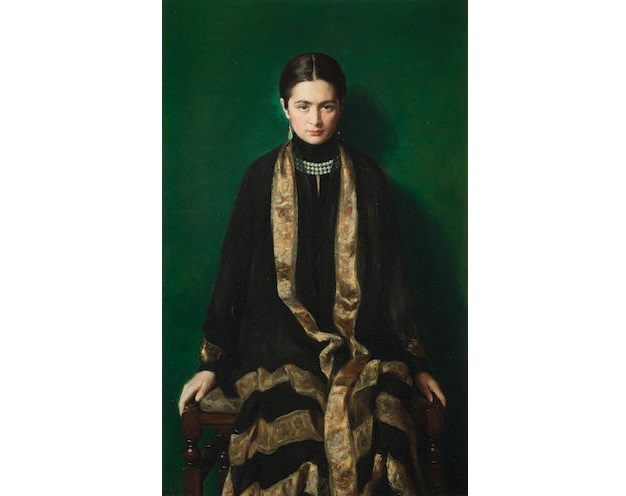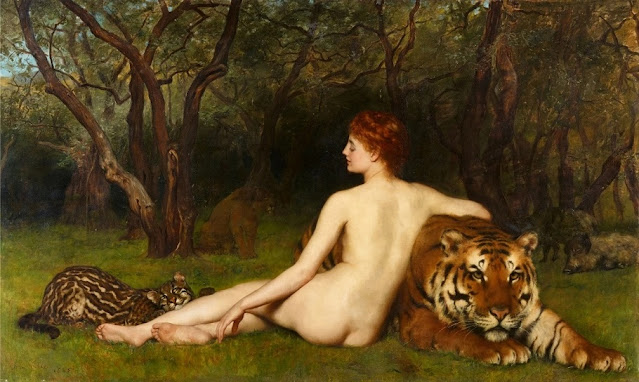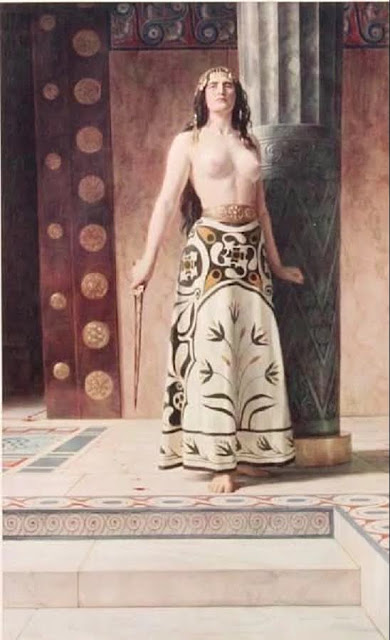In 1889 Collier married Mady's younger sister Ethel Huxley. Until the Deceased Wife's Sister's Marriage Act 1907 such a marriage was not possible in England, so the ceremony took place in Norway. By his second wife he had a daughter and a son, Sir Laurence Collier, who was the British Ambassador to Norway 1941–51.
John Collier, (1850–1934)
Lilith, c. 1892
Oil on canvas
Atkinson Art Gallery and Library, Southport, Sefton, Merseyside, England
In this oil painting JM Collier introduces us to a young and beautiful Lilith. A being of sinuous forms, of sinful sensuality that inch by inch shows us her white complexion, her reddish hair and abundant hair. Naked in the solitude of the forest and with an erotic gesture she embraces the snake, she seems to want to merge with it, the young woman lets the reptile surround her entire body, in her gesture she seems to reach ecstasy. The composition of the painting is vertical, belonging to the Pre-Raphaelite style, we observe how in the painting the figure stands out against the dark tones used in the background. More on this painting
Lottie Davies, After John Collier, (1850–1934)
Lilith
Photography
100cm x 54cm
Private collection
The subject of Lilith can be found in Babylonian mythology from the Third and Fourth Centuries and was retold in Hebrew scripture in the Alphabet of Sirach, which explains how she was created from the same earth as Adam before the creation of Eve. In a variation of her story from the Thirteenth Century, Lilith had refused to be subservient to Adam and had abandoned the Garden of Eden and coupled with the archangel Samael. By the nineteenth century the name Lilith had become synonymous with powerful female independence and primordial sexual allure and she was identified either as a demoness or enchantress, the original femme fatale. Rossetti seems to have regarded her as the latter. More on Lady Lilith
Collier's range of portrait subjects was broad. In 1893, for example, his subjects included Lovelace Stamer, Bishop of Shrewsbury; Sir John Lubbock FRS; A N Hornby (Captain of the Lancashire Eleven); Edward Augustus Inglefield (Admiral and Arctic explorer).
John Collier, (1850–1934)
Godiva, c. 1898 or before
Oil on canvas
H 142.2 x W 183 cm
Herbert Art Gallery & Museum
Lord Tennyson wrote a famous poem about Godiva in 1842 which encouraged many artists to paint her.
By the end of the Victorian age the Victoria and Albert Museum was famous for its collections of medieval architectural sculpture, and surely it is from there that Collier has gained his inspiration. Certainly Coventry was not at all like this but was a wooden, single-storey village. More on this painting
Lady Godiva (1066 and 1086), in Old English Godgifu, was a late Anglo-Saxon noblewoman who is relatively well documented as the wife of Leofric, Earl of Mercia, and a patron of various churches and monasteries. Today, she is mainly remembered for a legend dating back to at least the 13th century, in which she rode naked – covered only in her long hair – through the streets of Coventry to gain a remission of the oppressive taxation that her husband, Leofric, imposed on his tenants. The name "Peeping Tom" for a voyeur originates from later versions of this legend, in which a man named Thomas watched her ride and was struck blind or dead. More on Lady Godiva
His commissioned portrait of the Duke of York (later George V) as Master of Trinity House in 1901, and the Prince of Wales (later Edward VIII) were his major royal portraits. The latter work was hung in Durbar Hall, Jodhpur, Rajputana.
John Collier, (1850–1934)
Eve, c. 1911
Oil on canvas
Height: 160 cm (62.9 in); Width: 190 cm (74.8 in)
Private collection
Eve is a figure in the Book of Genesis in the Hebrew Bible. According to the creation myth of the Abrahamic religions, she was the first woman. In Islamic tradition, Eve is known as Adam's wife and the first woman although she is not specifically named in the Quran.
According to the second chapter of Genesis, Eve was created by God by taking her from the rib of Adam, to be Adam's companion. She succumbs to the serpent's temptation to eat the forbidden fruit from the tree of the knowledge of good and evil. She shares the fruit with Adam, and as a result the first humans are expelled from the Garden of Eden. Christian churches differ on how they view both Adam and Eve's disobedience to God, and to the consequences that those actions had on the rest of humanity. Christian and Jewish teachings sometimes hold Adam and Eve to a different level of responsibility for the fall, although Islamic teaching holds both equally responsible. More on Eve
Collier died in 1934. His entry in the Dictionary of National Biography (volume for 1931–40, published 1949) compares his work to that of Frank Holl because of its solemnity. This is only true, however, of his many portraits of distinguished old men – his portraits of younger men, women and children, and his so-called "problem pictures", covering scenes of ordinary life, are often very bright and fresh.
John Collier, (1850–1934)
Cassandra
Oil on board
62 x 48cm
Private collection
Cassandra or Kassandra was a Trojan priestess of Apollo in Greek mythology cursed to utter true prophecies, but never to be believed. In modern usage her name is employed as a rhetorical device to indicate someone whose accurate prophecies are not believed.
She was admired by the god Apollo, who sought to win her with the gift to see the future. According to Aeschylus, she promised him her favors, but after receiving the gift, she went back on her word and refused the god. The enraged added to it the curse that though she would see the future, nobody would believe her prophecies. In other sources, Cassandra broke no promise; the powers were given to her as an enticement. When these failed to make her love him, Apollo cursed Cassandra to always be disbelieved, in spite of the truth of her words. More on Cassandra
His entry in the Dictionary of Art (1996 vol 7, p569), by Geoffrey Ashton, refers to the invisibility of his brush strokes as a "rather unexciting and flat use of paint" but contrasts that with "Collier's strong and surprising sense of colour" which "created a disconcerting verisimilitude in both mood and appearance".
John Collier, (1850–1934)
The butterfly
Oil on canvas
44 x 56 in. (111.8 x 142.3 cm.)
Private collection
The Dictionary of Portrait Painters in Britain up to 1920 (1997) describes his portraits as "painterly works with a fresh use of light and colour".
Sixteen of John Collier's paintings are now in the collections of the National Portrait Gallery in London, and two are in the Tate Gallery. Four of the National Portrait Gallery paintings were in December 1997 on display: John Burns, Sir William Huggins, Thomas Huxley (the artist's father in law) and Charles Darwin (copies of the last two are also prominently displayed at the top of the staircase at the Athenaeum Club in London).
John Collier, (1850–1934)
Self Portrait of John Collier, circa 1882-1883
Oil on canvas
Height: 127.1 cm (50 in); Width: 101.4 cm (39.9 in)
National Portrait Gallery
A 1907 self-portrait has been preserved in the Uffizi in Florence which presumably commissioned it as part of its celebrated collection of artists’ self-portraits.
Lottie Davies, After John Collier, (1850–1934)
Clytemnestra, c. 1882
Oil on canvas
80 x 49 cm (31.5 x 19.3")
I have no further description, at this time
Clytemnestra, in Greek legend, a daughter of Leda and Tyndareus and wife of Agamemnon, commander of the Greek forces in the Trojan War. She took Aegisthus as her lover while Agamemnon was away at war. Upon his return, Clytemnestra and Aegisthus murdered Agamemnon. Clytemnestra was then killed by her son, Orestes, with the help of his sister Electra, in revenge for his father’s murder. More on Clytemnestra
After John Collier, (1850–1934)
Clytemnestra
Prints & Graphic Art
11 13/16 x 7 1/4in
Private collection
Other pictures may be seen in houses and institutions open to the public: his Clytemnestra, a large and striking painting of the murderess, is in the Guildhall Gallery of the City of London.
John Collier, (1850–1934)
Sentence of Death
Oil on canvas
Wolverhampton Art Gallery
This painting at first disappointed the critics, but quickly became very popular. Sadly the original work has not lasted well, and I rely on a reproduction made at the time.
At a time when disease and death were prominent in everyday life, this painting might seem quite ordinary. A young middle-aged man stares blankly at the viewer, having just been told by his doctor that he is dying. The doctor appears disengaged, and is reading from a book, looking only generally in the direction of his doomed patient. More on this painting
The Death Sentence was given by the widow of the artist to Wolverhampton Art Gallery. His portrait of the Earl of Onslow (1903), is at Clandon Park, Surrey (National Trust). His full-length portrait of Sir Charles Tertius Mander, first baronet, is at Owlpen Manor, Gloucestershire, with another version in the collection of the National Trust at Wightwick Manor, and his Lady Godiva is in the Herbert Art Gallery and Museum.
More on John Collier
Please visit my other blogs: Art
Collector, Mythology, Marine
Art, Portrait of a Lady, The
Orientalist, Art of the Nude and The
Canals of Venice, Middle
East Artists, 365
Saints and 365 Days, also visit my Boards on Pinterest
Images are copyright of their respective owners, assignees or others.
Some Images may be subject to copyright
I don't own any of these images - credit is always given when due unless
it is unknown to me. if I post your images without your permission, please tell
me.
I do not sell art, art prints, framed posters or reproductions. Ads are
shown only to compensate the hosting expenses.
If you enjoyed this post, please share with friends and family.
Thank you for visiting my blog and also for liking its posts and pages.
Please note that the content of this post primarily consists of articles
available from Wikipedia or other free sources online.
















.jpg)

No comments:
Post a Comment